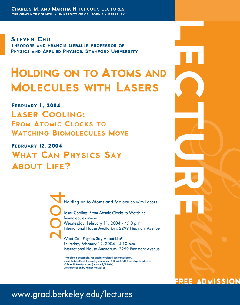
Steven Chu
Theodore and Francis Geballe Professor of Physics and Applied Physics, Stanford University
Charles M. and Martha Hitchcock Lectures
February 13, 2004International House, Chevron Auditorium — 2299 Piedmont Avenue, UC Berkeley Campus
A Nobel Laureate and distinguished physicist, Chu is credited with developing new methods to cool and trap atoms with laser lights. This groundbreaking scientific research uses advanced optical technology and has implications not only for physics, but also for biology. … Continued
International House, Chevron Auditorium - 2299 Piedmont Avenue, UC Berkeley Campus Berkeley Graduate Lectures [email protected] false MM/DD/YYYYA Nobel Laureate and distinguished physicist, Chu is credited with developing new methods to cool and trap atoms with laser lights. This groundbreaking scientific research uses advanced optical technology and has implications not only for physics, but also for biology.
About Steven Chu
A Nobel Laureate and distinguished physicist, Chu is credited with developing new methods to cool and trap atoms with laser light. This groundbreaking scientific research uses advanced optical technology and has implications not only for physics, but also for biology. Although Chu was not trained as a molecular biologist, he and his students use this technology to simultaneously visualize and manipulate individual molecules of DNA. Chu has also made outstanding contributions to the field of precision atomic spectroscopy, for application in diverse problems of metrology, or the weighing and measuring of atoms. He is also widely recognized for important contributions in both atomic and polymer physics. Chu is co-author of the book, Laser Spectroscopy (2002). Born in 1948 in St. Louis, Chu was a self-described “academic black sheep” in a family of accomplished scholars. He discovered his interest in physics in high school and started to study seriously, earning a B.S. in physics from the University of Rochester in 1970. In 1976, he received his Ph.D. in physics from University of California, Berkeley, where he studied under the distinguished physicist, Eugene Commins. In 1978, Chu took a temporary leave from academia to work at Bell Laboratories where he was named as head of the Quantum Electronics Research Department in 1983. Chu accepted a physics professorship at Stanford University in 1987, and in 1990, was named as the Theodore and Francis Geballe Professor of Physics and Applied Physics. Chu’s achievements have been recognized with numerous honors, including the Brioda Prize for Laser Spectroscopy in 1987 and a Guggenheim Fellowship in 1996. In 1997 he was co-winner of the Nobel Prize in Physics for his research and developments in the study of the cooling and trapping of atoms with lasers.